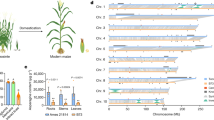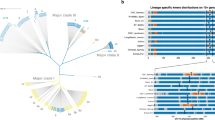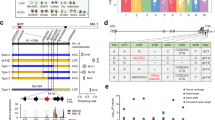Abstract
High-molecular-weight glutenin subunits (HMW-GS), one class of seed storage proteins, are important determinants of the bread-making quality of wheat flour. To change the amount and composition of these proteins via genetic engineering, a gene encoding a novel hybrid subunit under the control of native HMW-GS regulatory sequences was inserted into wheat. Of 26 independent transgenic lines identified by bialaphos selection, 18 expressed the cotransformed hybrid HMW-GS gene in their seed. The hybrid subunit accumulated to levels comparable to those of the native HMW-GS. These results show that a native HMW-GS gene promoter can be used to obtain high levels of expression of seed storage and, potentially, other proteins in transgenic wheat endosperm. Transgene expression was stable for at least three seed generations in the majority of lines. These experiments demonstrate the feasibility of constructing wheat plants with novel seed protein compositions.
This is a preview of subscription content, access via your institution
Access options
Subscribe to this journal
Receive 12 print issues and online access
$209.00 per year
only $17.42 per issue
Buy this article
- Purchase on Springer Link
- Instant access to full article PDF
Prices may be subject to local taxes which are calculated during checkout
Similar content being viewed by others
References
MacRitchie, F. 1992. Physiochemical properties of wheat proteins in relation to functionality. Adv. Food and Nutrition Res. 36: 1–87.
Shewry, P.R., Halford, N.G., and Tatham, A.S. 1989. The high molecular weight subunits of wheat, barley and rye: genetics, molecular biology, chemistry and role in wheat gluten structure and functionality, pp. 163–219 in Oxford surveys of plant molecular and cell biology. Miflin, B.J. (ed.). Oxford University Press, Oxford, UK.
Weegels, P.L., Hamer, R.J., and Schofield, J.D. 1996. Functional properties of wheat glutenin. J. Cer. Sci. 23: 1–18.
Payne, P.I. 1987. Genetics of wheat storage proteins and the effect of allelic variation on breadmaking quality. Annu. Rev. Plant Physiol. 38: 141–153.
Shewry, P.R., Tatham, A.S., Barro, F., Barcelo, P., and Lazzeri, P. 1995. Biotechnology of breadmaking: Unraveling and manipulating the multi-protein gluten complex. Bio/Technology 13: 1185–1190.
Vasil, V., Castillo, A.M., Fromm, M.E., and Vasil, I.K. 1992. Herbicide resistant fertile transgenic wheat plants obtained by microprojectile bombardment of regenerable embryogenic callus. Bio/Technology 10: 667–674.
Vasil, V., Srivastava, V., Castillo, A.M., Fromm, M.E., and Vasil, I.K. 1993. Rapid production of transgenic wheat plants by direct bombardment of cultured immature embryos. Bio/Technology 11: 1553–1558.
Weeks, J.T., Anderson, O.D., and Blechl, A.E. 1993. Rapid production of multiple independent lines of fertile transgenic wheat (Triticum aestivum). Plant Physiol. 102: 1077–1084.
Shani, N., Steffen-Campbell, J.D., Anderson, O.D., Greene, F.C., and Galili, G. 1992. Role of amino- and carboxy-terminal regions in the folding and oligomerization of wheat high molecular weight glutenin subunits. Plant Physiol. 98: 433–441.
Rosenberg, A.H., Lade, B.N., Chui, D., Lin, S., Dunn, J.J., and Studier, F.W. 1987. Vectors for selective expression of cloned DNAs by T7 RNA polymerase. Gene 56: 125–135.
Cornejo, M.-J., Luth, D., Blankenship, K.M., Anderson, O.D., and Blechl, A.E. 1993. Activity of a maize ubiquitin promoter in transgenic rice. Plant Mol. Biol. 23: 567–581.
Anderson, O.D., Greene, F.C., Yip, R.E., Halford, N.G., Shewry, P.R., and Malpica-Romero, J.-M. 1989. Nucleotide sequences of the two high-molecular-weight glutenin genes from the D-genome of a hexaploid bread wheat, Triticum aestivum L. cv Cheyenne. Nucleic Acids Res. 17: 3156–3157.
Bietz, J.A. and Simpson, D.G. 1992. Electrophoresis and chromatography of wheat proteins: available methods, and procedures for statistical evaluation of the data. J. Chromatography. 624: 53–80.
Matzke, M.A., and Matzke, J.M. 1995. How and why do plants inactivate homologous (trans)genes? Plant Physiol. 107: 679–685.
Vain, P., McMullen, M.D., and Finer, J.J. 1993. Osmotic treatment enhances particle bombardment-mediated transient and stable transformation of maize. Plant Cell Rep. 12: 84–88.
Laemmli, U.K. 1970. Cleavage of structural proteins during the assembly of the head of bacteriophage T4. Nature 227: 680–685.
Neuhoff, V., Arold, N., Taube, D., and Ehrhardt, W. 1988. Improved staining of proteins in polyacrylamide gels including isoelectric focusing gels with clear background at nanogram sensitivity using Coomassie Brilliant Blue G-250 and R-250. Electrophoresis 9: 255–262.
Author information
Authors and Affiliations
Rights and permissions
About this article
Cite this article
Blechl, A., Anderson, O. Expression of a novel high-molecular-weight glutenin subunit gene in transgenic wheat. Nat Biotechnol 14, 875–879 (1996). https://doi.org/10.1038/nbt0796-875
Received:
Accepted:
Issue Date:
DOI: https://doi.org/10.1038/nbt0796-875
This article is cited by
-
Effects of Aegilops longissima chromosome 1Sl on wheat bread-making quality in two types of translocation lines
Theoretical and Applied Genetics (2024)
-
Establishment of a stable particle bombardment transformation method in Korean commercial wheat (Triticum aestivum L.) varieties
Plant Biotechnology Reports (2021)
-
A large-scale chromosome-specific SNP discovery guideline
Functional & Integrative Genomics (2017)
-
The distribution of cotransformed transgenes in particle bombardment-mediated transformed wheat
Transgenic Research (2015)
-
Employment of wheat-rye translocation in wheat improvement and broadening its genetic basis
Journal of Crop Science and Biotechnology (2014)



